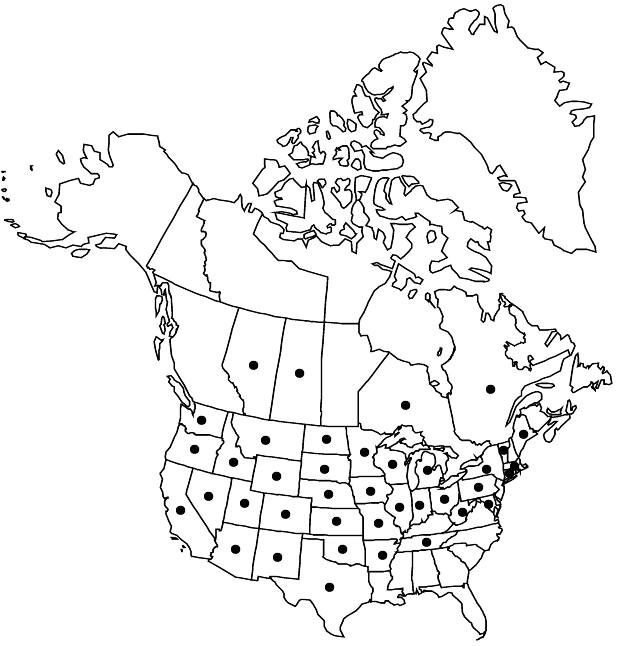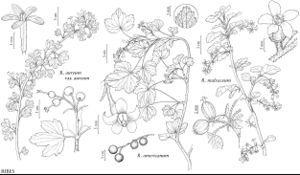Difference between revisions of "Ribes aureum"
Fl. Amer. Sept. 1: 164. 1813 ,.
FNA>Volume Importer |
FNA>Volume Importer |
||
| Line 21: | Line 21: | ||
|distribution=North America. | |distribution=North America. | ||
|discussion=<p>Varieties 3 (3 in the flora).</p><!-- | |discussion=<p>Varieties 3 (3 in the flora).</p><!-- | ||
| − | --><p><i>Ribes aureum</i> was introduced into cultivation in Europe early in the nineteenth century (F. V. Coville 1903). It is a major host of pinyon blister rust in Arizona, Colorado, and Utah, and of pinyon leaf rust in New Mexico (E. P. Van Arsdel and B. W. Geils 2004). <i>Ribes aureum</i> is a variable complex and the varieties may seem to intergrade. In California, < | + | --><p><i>Ribes aureum</i> was introduced into cultivation in Europe early in the nineteenth century (F. V. Coville 1903). It is a major host of pinyon blister rust in Arizona, Colorado, and Utah, and of pinyon leaf rust in New Mexico (E. P. Van Arsdel and B. W. Geils 2004). <i>Ribes aureum</i> is a variable complex and the varieties may seem to intergrade. In California, <i></i>var.<i> aureum</i> occurs in sagebrush scrub or coniferous forests at higher elevations (800–2600 m) than <i></i>var.<i> gracillimum</i>; the sepals of <i></i>var.<i> aureum</i> are longer than those of <i></i>var.<i> gracillimum</i> (5–8 mm versus 3–4 mm), and its hypanthium is noticeably shorter relative to the sepals. Leaves of <i></i>var.<i> aureum</i> are more highly lobed and are sparsely glandular in the Pacific Northwest and less lobed and more densely glandular in the southwest (H. D. Hammond, pers. comm.). In most of its range, <i></i>var.<i> villosum</i> is so conspicuously villous as to be unmistakable; in the west some plants with strikingly long hypanthia are scarcely villous.</p> |
|tables= | |tables= | ||
|references= | |references= | ||
| Line 52: | Line 52: | ||
-->{{#Taxon: | -->{{#Taxon: | ||
name=Ribes aureum | name=Ribes aureum | ||
| − | |||
|authority=Pursh | |authority=Pursh | ||
|rank=species | |rank=species | ||
| Line 64: | Line 63: | ||
|publication year= | |publication year= | ||
|special status= | |special status= | ||
| − | |source xml=https://jpend@bitbucket.org/aafc-mbb/fna-data-curation.git/src/ | + | |source xml=https://jpend@bitbucket.org/aafc-mbb/fna-data-curation.git/src/f50eec43f223ca0e34566be0b046453a0960e173/coarse_grained_fna_xml/V8/V8_13.xml |
|genus=Ribes | |genus=Ribes | ||
|species=Ribes aureum | |species=Ribes aureum | ||
Revision as of 23:25, 16 December 2019
Plants 1–3 m. Stems erect, glabrous or finely puberulent or villous, glabrescent; spines at nodes absent; prickles on internodes absent. Leaves: petiole (0.4–)1–3(–4.8) cm, margins of young leaves often with slender extensions like multicelled hairs, surfaces finely pubescent, glabrescent; blade broadly deltate-ovate to obovate, 3(–5)-lobed, cleft less than to slightly more than 1/2 to midrib (sometimes proximal leaves again shallowly lobed), (1–)1.6–3.6(–5.7) cm, base broadly cuneate to somewhat cordate, surfaces sometimes with colorless or yellowish, nearly sessile glands, finely pubescent or glabrous, glabrescent, lobes oblong-rounded, margins entire or with 2–5 rounded teeth, apex acute to obtuse. Inflorescences ascending to reflexed, 5–18-flowered racemes, 3–7 cm, axis glabrous, finely pubescent, or densely villous, flowers evenly spaced. Pedicels jointed, 2–8 mm, glabrous or densely villous; bracts broadly deltate to obovate (similar to leaves), 4–9 mm, glabrous or densely villous. Flowers: hypanthium yellow to yellowish green, narrowly tubular, 6–20 mm, glabrous; sepals not overlapping, spreading, usually not reflexed, golden yellow, oblong-elliptic, 3–8 mm; petals connivent, erect, yellow to orange or deep red, oblong-obovate, not conspicuously revolute or inrolled, 2–3(–4) mm; nectary disc not conspicuous; stamens nearly as long as petals; filaments slightly expanded at base, 0.9–1.5(–2.2) mm, glabrous; anthers white, oblong, 1.1–2 mm, apex minutely apiculate; ovary glabrous; styles connate almost to stigmas, (8.5–)9.8–12.5 mm, glabrous. Berries palatable, usually red, orange, brown, or black, rarely yellow, globose, 5.2–10 mm, glabrous. 2n = 16.
Distribution

North America.
Discussion
Varieties 3 (3 in the flora).
Ribes aureum was introduced into cultivation in Europe early in the nineteenth century (F. V. Coville 1903). It is a major host of pinyon blister rust in Arizona, Colorado, and Utah, and of pinyon leaf rust in New Mexico (E. P. Van Arsdel and B. W. Geils 2004). Ribes aureum is a variable complex and the varieties may seem to intergrade. In California, var. aureum occurs in sagebrush scrub or coniferous forests at higher elevations (800–2600 m) than var. gracillimum; the sepals of var. aureum are longer than those of var. gracillimum (5–8 mm versus 3–4 mm), and its hypanthium is noticeably shorter relative to the sepals. Leaves of var. aureum are more highly lobed and are sparsely glandular in the Pacific Northwest and less lobed and more densely glandular in the southwest (H. D. Hammond, pers. comm.). In most of its range, var. villosum is so conspicuously villous as to be unmistakable; in the west some plants with strikingly long hypanthia are scarcely villous.
Selected References
None.
Key
| 1 | Hypanthium lengths 1.5-2 times sepals. | Ribes aureum var. aureum |
| 1 | Hypanthium lengths 2-3 times sepals | > 2 |
| 2 | Petals yellow, turning deep red; hypanthia 6-12 mm. | Ribes aureum var. gracillimum |
| 2 | Petals yellow, turning orange; hypanthia 9-20 mm. | Ribes aureum var. villosum |
